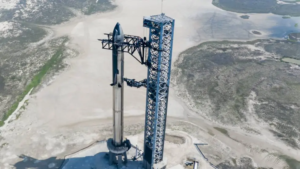SpaceX’s Starship rocket, the most powerful ever built, exploded in midair minutes after liftoff from a launchpad in South Texas on Thursday. The uncrewed test flight was the first attempt to reach orbit with the gigantic spacecraft that SpaceX founder Elon Musk hopes will eventually carry humans to the moon and Mars.
The launch was initially delayed by two minutes due to minor technical snags, but at 9:30 a.m. EDT, the 33 methane-fueled Raptor engines powering the Super Heavy first stage roared to life, generating 16 million pounds of thrust — twice the power of NASA’s SLS moon rocket.
The rocket climbed straight up and then tilted over onto an easterly trajectory

toward the Florida Straits. However, on-screen graphics in the SpaceX webcast showed that six of the 33 Raptor engines had either shut down or failed to ignite during ascent — three in an outer ring of 20 fixed Raptors and three of the 13 central steerable engines.
One minute and 55 seconds after liftoff, the rocket’s exhaust plume suddenly changed, becoming distinctly asymmetrical, indicating a major malfunction of some sort. The rocket soon appeared to begin wobbling on its long axis like a toy top slowing down.
At 2 minutes and 15 seconds into flight, a bright flash was seen near the base of the rocket, followed by a loud boom and a fireball. Debris rained down over the Gulf of Mexico as SpaceX engineers declared a “rapid unscheduled disassembly” or RUD — a euphemism for an explosion.
“Starship just experienced what we call a rapid unscheduled disassembly, or a RUD, during ascent,” said SpaceX engineer John Insprucker, serving as a launch commentator on the company’s webcast. “Now this was a development test, this was the first test flight of Starship, and the goal is to gather the data and as we said, clear the pad and get ready to go again. So you never know exactly what’s going to happen, but as we promised, excitement is guaranteed! Starship gave us a rather spectacular end to what was truly an incredible test.”
Musk tweeted his congratulations to the SpaceX team on an “exciting test launch” and said they learned a lot for the next attempt in a few months. He did not provide any details on what caused the explosion or how it would affect the company’s plans for future Starship flights.
SpaceX has been developing Starship as a reusable super-heavy-lift rocket and spacecraft that can carry up to 100 tons of cargo or 100 people to low Earth orbit and beyond. The rocket stands 394 feet tall and has a diameter of 30 feet. It consists of two stages: the Super Heavy booster that provides most of the thrust at liftoff and the Starship upper stage that houses the payload and crew.
The company has already conducted several suborbital test flights with Starship prototypes at its Boca Chica facility, landing successfully twice after reaching altitudes of about six miles. The orbital test flight was intended to demonstrate Starship’s ability to reach speeds fast enough to enter orbit before splashing down in the Pacific Ocean near Hawaii.
“Starship is the biggest rocket ever made,” Musk said prior to the launch. “It’s over twice the thrust of a Saturn 5, the Saturn 5 moon rocket, which is largest rocket ever to get to orbit, it’s roughly twice the mass. So, we’ve got 33 engines on the booster, we’ve got six engines on the upper stage of the ship. It’s a lot of engines.
“So I guess I would just like to set expectations low. If we get far enough away from the launch pad before something goes wrong, then I think I would consider that to be a success. Just don’t blow up the launch pad.”
SpaceX has also won a $2.9 billion contract from NASA to use Starship as a lunar lander for the Artemis program, which aims to put humans on the moon by 2025. However, that contract is currently under protest by rival bidders Blue Origin and Dynetics.
Despite the setback, SpaceX remains the dominant company in global spaceflight. Its Falcon 9 rockets have already traveled to space 25 times in 2023, with the most recent launch concluded successfully Wednesday.











